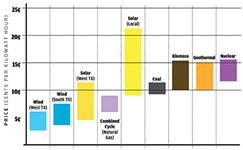Here Comes MetroRapid
Cap Metro rolls out its big bendy buses, the next mode in multimodal
By Richard Whittaker, Fri., Jan. 24, 2014
"If you give people good coffee and good tunes, they will park and ride." In 1992's ode to progressive Seattle, Singles, that's how transportation planner Steve Dunne sells the idea of commuter rail. Replace coffee with comfy seats, and tunes with free wi-fi, and that's how Capital Metro hopes to sell its newest development, MetroRapid buses, to Austin's ever-growing business commuter community.
This Sunday, Jan. 26, Cap Metro will launch its first MetroRapid service: the 801, an express route from Tech Ridge to Southpark Meadows, linking Lamar, Guadalupe, and South Congress. It's one more component of Project Connect, the joint initiative between the city of Austin and Cap Metro to construct a genuine rapid mass transit system involving express buses, and light and commuter rail. The plan is to create a fast, clean, modern alternative for commuters – and in the process take some of the increasing strain off Austin's overburdened roads. As the first local example of bus rapid transit (BRT), Cap Metro president and CEO Linda Watson called MetroRapid "somewhere between bus and rail. ... It's smart buses, operating on smart streets, stopping at smart stations."
The plan is to get 21,000 boardings a day on MetroRapid within the first 24 months. It should be easy for those passengers to spot the new service. At 60 feet, the vehicles (transit staff try to avoid the word "buses" for them) are half again as long as the normal Cap Metro rolling stock. The other clue is that these are "articulated" buses; they look like two buses glued together, with an accordion in between. That means the back and front move independently, earning the nicknames "bendy buses," "caterpillar buses," and "Slinky buses."
A common sight in many American cities, including Minneapolis-St. Paul, Chicago, and Houston, they look cumbersome, but in the hands of an experienced driver they actually handle a little more easily than the regular 40-footers. Inside, the vehicles don't look like the aging and crowded units they're replacing; they're airy and spacious, with taller ceilings, higher windows, more seat padding than regular buses, plus free wi-fi. There are also wider-than-standard doors, and more of them. Unlike regular Cap Metro buses, where passengers can only embark at the front, passengers will be able to get on and off through any door. That's an important part of their design: With three doors, plus card readers and mobile phone scanners at the two rear doors, a MetroRapid bus can load and unload more quickly.
First of Many
That's half of the equation. The other half is the stops – or, in MetroRapid lingo, "stations." Spacious, shaded, off the sidewalk, and with digital displays giving real-time arrival information, they're located at the biggest apartment complexes, or the biggest firms and office complexes. There will also be bus "priority lanes" on Guadalupe and Lavaca, and MetroRapid vehicles will communicate with lights at crossings to keep them green longer for bus passage. Combine everything, and Cap Metro hopes that a host of non-traditional bus riders will be coaxed to park and ride. Watson said, "Everything is geared to be rapid."
The 801 is just stage one of the planned MetroRapid rollout. A second route, the 803, will launch later this summer, connecting the Domain to Westgate via Burnet Road and South Lamar – and if those two routes are successful, then Cap Metro could consider more later. That success could depend heavily on UT riders – after all, both routes go through the Forty Acres, and the 803 will provide a faster connection to the Pickle Research Campus. According to Dottie Watkins, vice president of Bus & Paratransit Services, UT is "very excited about what the 803 can mean for that campus. ... They have a lot of opportunity to expand up there, they do a ton of research up there, and there's a lot of folks who've moved up there."
MetroRapid arrives while Austin's ever-expanding population – an estimated 100 new residents and 70 additional cars every day – puts greater pressure than ever on the road system. If MetroRapid is successful, it could slow, mitigate, or even reverse the impact of some of those white-collar commuters. Dan Dawson, Cap Metro's vice president of marketing and communications, has been through a BRT rollout before, having lived in Santa Monica, Calif., when the city's Big Blue Bus agency introduced its BRT system. He said, "It's not something you can expect to put on the street and expect 50,000 new riders on Friday. But what I personally have seen is that when that vehicle is passing you by in the transit lane when you're in your car, you're going to say, 'Why aren't I in there?'"
False Economies?
The signs of the city's growth are obvious. Speaking from his Downtown office, city of Austin Director of Transportation Rob Spillar said, "I count 14 tower cranes visible from my window right now. That's another 40,000 or 60,000 residents and employees headed to Austin right now." Spillar called that growth a good problem to have, since it's an indicator of the city's economic health. "You don't hear Detroit complaining about congestion, or Chicago," he said. But there's congestion, and then there's congestion – and Austin is running out of road space now. Spillar added, "All our gateways into Central Austin are full, so BRT allows us to increase the carrying capacity of the roads we have right now."

Chris Riley is watching the introduction from two different perspectives: first, as a Council member, and secondly, as a member of the Cap Metro board. He said, "From the Cap Metro perspective, it's a considerable step forward in terms of the effort to enhance our bus services. From the city perspective, it's particularly exciting to see transit come into its own, particularly in the urban core." Yet both Spillar and Riley are realistic that drivers will need more incentive to ride than the existing system may provide. With such amenities as wi-fi commonplace in other cities, Riley said, "Passengers have raised expectations around the world in regard to transit."
But with the introduction of express routes, there's an inevitable trade-off. The 801 will effectively replace two current services: the express 101, and the local 1L. For most of its route, the 1L stops at every other block; 801 stations can be more than a mile apart. While the other local route along the corridor – the 1M, soon to be renumbered the 1 – will still use all the same stops as before, there'll be a drop in overall frequency. Currently, at rush hour there's supposed to be a 1L or a 1M at those stops every 10 to 12 minutes. Under the new schedule, that will drop to once every 22 minutes or so. Cap Metro's thinking is that, in addition to new commuters lured out of their cars, there will be some regulars from the 101 or 1L on the 801.
But Mike Dahmus, a former member of the city's Urban Transportation Commission, is concerned that the agency is cannibalizing those existing routes. Dahmus is a persistent thorn in Cap Metro's side (his Twitter feed and blog – "M1EK's Bake-Sale of Bile" – are filled regularly with anti-agency postings). For him, it's not just about the speed – although, as he points out, current calculations show the 801 will be no faster than the 101 – but about the impact of removing one of the local lines. It's simple math: Cap Metro has been installing 43 new dedicated MetroRapid "stations" for the 801 (with an additional 34 for the 803), and that's dramatically fewer than the 239 "stops" for the 1L. If you're waiting at one of the fancy new stations, he said, "You're not losing any buses but you're not getting any more buses. If you're at a stop that is only served by locals, you're losing half your buses."
In part, his frustration comes because the 1L/1M is the most heavily used part of the entire Cap Metro system, with the greatest number of passes sold, and therefore the least dependent on the 1% sales tax that subsidizes Cap Metro operations. Dahmus said, "The question is, why are we making service worse for people who are coming closest to paying their way?" He fears that Cap Metro is sacrificing an existing busy local service to make the express service more viable. "They want the bus with the higher fares to be more full than it would be if the 1L was still running."
Watkins puts the agency's response bluntly: "Because funds are not unlimited." While non-express riders will still have the renumbered 1M, it's simply not economically viable to keep the 1L and lay the 801 over its service map. She said, "We would love to be able have more frequent service, even on some of our core local routes, but as all agencies do, we struggle with what's the best use of our limited resources."
Yet if the loss of local service along the 801 is a concern, then the 803's late-summer rollout could be a real headache. Initially, Cap Metro planned that the 803 replace the only local service along that route, the 3 Burnet/Manchaca. However, the agency has pumped the brakes on that idea, and its planning department is considering options for a local route. For Dahmus, that's less of an immediate problem than the removal of the 1L. "Unlike the change in the 801, the 803 is an increase in capacity," he said. "You can say it's more frequent and you don't have to have your fingers crossed. You can say it's faster, and you don't have to have your fingers crossed." However, Burnet Road is one of the fastest developing areas of town, with several apartment complexes either being built or in the planning stage. Dahmus said, "If you look at Burnet 10 years forward, you could look at an unbroken string of three- to four-story buildings with no stops."
The Railing Over Rail
And then there's rail. Dahmus is one of a vocal number of transit advocates who want the city's proposed urban rail to run up Guadalupe and Lamar, rather than the currently favored Red River route, and MetroRapid blocks that plan, at least temporarily. Watson's counter-argument is simple: MetroRapid doesn't rule out rail on Guadalupe and Lamar for all time. Moreover, Austinites probably wouldn't be having this argument if voters had approved the last proposal for commuter rail up Lamar/ Guadalupe in 2000. But they didn't, and so MetroRapid is the closest thing to rail the city can get on that artery without a massive injection of voter-approved cash. MetroRapid was in part a response to that bond failure; when Cap Metro started planning the routes in 2009, they say, there was no timeline for another rail bond.
There is also no guarantee that voters will back this year's bond. Moreover, since the feds have sunk $38 million into financing the BRT project, they're highly unlikely to back an alternative until they've got their money's worth.
Whatever happens, Council Member Riley sees MetroRapid as an inevitable next step in Austin's transportation evolution – which may not always be painless. He said, "We've talked for many years about being a multimodal city, but obviously cars are the dominant form of commuting, and we've seen that's gotten increasingly problematic." While some drivers may shift their commute over to transit, others may fume about the dedicated bus lanes and the resultant loss of parking. However, Riley described the dedicated lanes as "the first step in giving transit the priority it deserves."
For the moment, Cap Metro is most concerned about a smooth rollout. The city's Public Works Department has promised that it will have its long-running Eighth Street renovations far enough along that that at least the priority bus lanes on Guadalupe and Lavaca will be in place before the 801 starts running. After that, Watson promises, there will be "close monitoring" of how many riders are getting on and off, and the tougher calculation of how many riders have been lost. Long term, that could mean further route adjustments or additional stops.
Riley summarized, "It's a balance and I'm not going to tell you that we've definitely hit the balance right. We'll probably have to make adjustments." In the meantime, as Austin's commuters adapt to and hopefully adopt the new service, he cited what one mass transit expert told him: "His main advice was to remember that this is a work in progress. This won't be a panacea from day one."
Got something to say on the subject? Send a letter to the editor.











